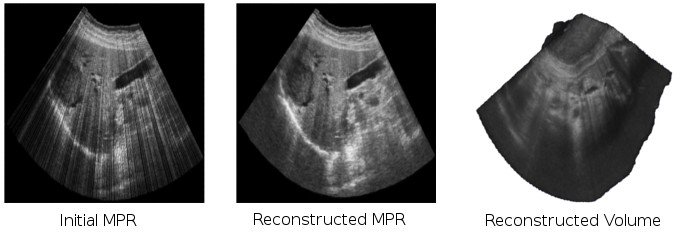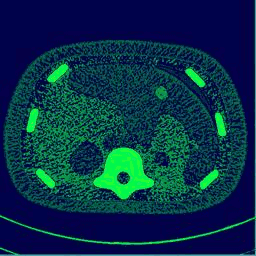Master of Science in Informatics - Thesis
GPU Ultrasound Simulation and Volume Reconstruction
Student: Athanasios KaramalisAdvisor: Nassir Navab
Supervision by: Oliver Kutter and Wolfgang Wein
In collaboration with Siemens Corporate Research (SCR), Princeton, NJ, USA
Abstract
Medical ultrasound imaging has been in clinical use for decades, however, acquisition and interpretation of ultrasound images still requires experience. For this reason, ultrasound simulation for training purposes is gaining importance. Additionally, simulated images can be used for the multimodal registration of Ultrasound and Computed Tomography (CT) images. The simulation process is a computationally demanding task. Thus, in this thesis a simulation method, accelerated by modern graphics hardware (GPU), is introduced. The accelerated simulation utilizes a ray-based simulation model in order to provide real-time high-throughput image simulation for training and registration purposes. Wave-based simulation methods are computationally even more demanding and have been considered unsuitable for real-time applications. In the scope of this thesis, wave-based models have been investigated, including the Digital Waveguide Mesh and the Finite-Difference Time-Domain method for solving Westervelt's equation. Initial results demonstrate the feasibility of performing near real-time wave-based ultrasound simulation using graphics hardware. Furthermore, a new algorithm is introduced for volumetric reconstruction of freehand (3D) ultrasound. The proposed algorithm intelligently divides the work between CPU and GPU for optimal performance. The results demonstrate superior performance and equivalent reconstruction quality compared to existing state of the art methods. GPU accelerated ultrasound simulation and freehand volume reconstruction are key components for fast 3D-3D (dense deformable) multimodal registration of Ultrasound and CT images, which is subject of current ongoing work.Download
Images
- GPU freehand ultrasound reconstruction:

- GPU ray-based ultrasound simulation:

- GPU wave-based ultrasound simulation using the Westervelt equation:

The animation shows the combination of multiple horizontally aligned single sound sources, which combine into a wavefront that propagates through the modeled tissue. The medium was modeled using a manually segmented CT phantom dataset, where each segmented voxel is color labeled in the animation. For each voxel category the sound propagation speed in the medium is defined, with a total of 5 different speeds being defined for the simulation, namely (600, 1480 1555, 1565, 4080 )[m/s]. The reflections in the medium result from the difference in propagation speed between the mediums, whereas, the reflections at the edge of the computational grid result from missing ABC boundary conditions.
| ProjectForm | |
|---|---|
| Title: | GPU Ultrasound Simulation and Volume Reconstruction |
| Abstract: | Medical ultrasound imaging has been in clinical use for decades, however, acquisition and interpretation of ultrasound images still requires experience. For this reason, ultrasound simulation for training purposes is gaining importance. Additionally, simulated images can be used for the multimodal registration of Ultrasound and Computed Tomography (CT) images. The simulation process is a computationally demanding task. Thus, in this thesis a simulation method, accelerated by modern graphics hardware (GPU), is introduced. The accelerated simulation utilizes a ray-based simulation model in order to provide real-time high-throughput image simulation for training and registration purposes. Wave-based simulation methods are computationally even more demanding and have been considered unsuitable for real-time applications. In the scope of this thesis, wave-based models have been investigated, including the Digital Waveguide Mesh and the Finite-Difference Time-Domain method for solving Westervelt's equation. Initial results demonstrate the feasibility of performing near real-time wave-based ultrasound simulation using graphics hardware. Furthermore, a new algorithm is introduced for volumetric reconstruction of freehand (3D) ultrasound. The proposed algorithm intelligently divides the work between CPU and GPU for optimal performance. The results demonstrate superior performance and equivalent reconstruction quality compared to existing state of the art methods. GPU accelerated ultrasound simulation and freehand volume reconstruction are key components for fast 3D-3D (dense deformable) multimodal registration of Ultrasound and CT images, which is subject of current ongoing work. |
| Student: | Athanasios Karamalis |
| Director: | Nassir Navab |
| Supervisor: | Oliver Kutter Wolfgang Wein |
| Type: | Master Thesis |
| Area: | Registration / Visualization, Medical Imaging |
| Status: | finished |
| Start: | 2008/08/15 |
| Finish: | 2008/02/15 |
| Thesis (optional): | |
| Picture: | |